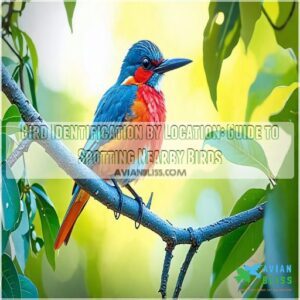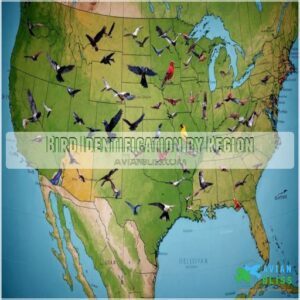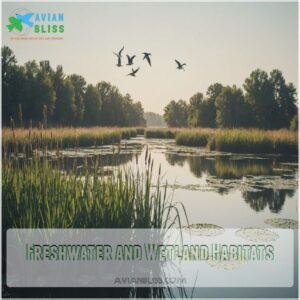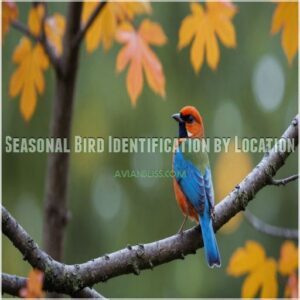This site is supported by our readers. We may earn a commission, at no cost to you, if you purchase through links.

Different regions host unique avian characters.
In eastern North America, you might spot a vibrant cardinal, while western areas boast the flashy Steller’s jay.
Bird habitats are like their favorite hangouts—forests shelter woodpeckers; wetlands attract herons.
Peek into birding guides specific to your area to discover who’s who.
Chat with local birding groups; they love sharing secret birdwatching spots!
And don’t just rely on visuals—learning to recognize bird songs can make you a pro.
Ready to explore chirpy secrets each season brings?
Let’s wing it together!
Table Of Contents
- Key Takeaways
- Bird Identification by Region
- Habitat-Based Bird Identification
- Identifying Birds by Geographic Features
- Seasonal Bird Identification by Location
- Advanced Bird Identification Techniques by Location
- Frequently Asked Questions (FAQs)
- How do you identify birds in North America?
- Where can I find information about birding?
- Where can I find bird lists & bird details?
- How do I identify birds by habitat and range?
- How do I identify birds in my area?
- What is the best free bird identifier app?
- What is the best website to identify birds?
- How do I tell what kind of bird I found?
- How do migration patterns affect bird identification?
- What tools help with coastal bird identification?
- Can urban noise hinder bird identification by sound?
- How do climate changes impact bird locations?
- What are unique challenges of desert bird identification?
- Conclusion
Key Takeaways
- You’ll identify birds more easily by understanding their preferred habitats and regional distributions.
- Mastering bird songs and calls significantly improves your identification skills.
- Seasonal migration patterns influence which birds you’ll spot in a given location.
- Combining multiple identification methods—sight, sound, behavior, and location—increases your accuracy.
Bird Identification by Region
When identifying birds by region, consider the local habitats and the specific species that thrive there.
Even if you’re not an ornithologist, spotting a Northern Cardinal in Eastern North America or a majestic Red-tailed Hawk soaring over open fields can be thrilling and rewarding.
Eastern North America
In Eastern North America, bird identification is a rewarding hobby—it’s like a treasure hunt.
From vibrant Northern Cardinals to clever Blue Jays, these common birds fill local parks and backyards.
To enhance your birding experience, check out the Location Bird Guide products available online at Birding Location Guides.
Use birdwatching tips and bird range maps to navigate birding locations.
Beware of Bird ID Challenges, but join Citizen Science projects to help with conservation concerns and connect with fellow enthusiasts.
Western North America
Imagine standing on the Pacific Coast, binoculars in hand, ready to spot California Condors soaring high.
The Pacific Northwest region is home to various common songbirds, including House Finches, American Goldfinches, and Purple Finches, which can be found in backyards and woodlands, offering a glimpse into their unique characteristics and behaviors common songbirds of the pacific northwest. Western North America’s birding hotspots offer an incredible bird species identification experience.
From Desert Birds to Mountain Birds, every sighting feels like discovering a new level in your bird field guide.
Western Raptors also add excitement to your bird identification by location adventures.
Central and Southern United States
Exploring bird diversity in the Central and Southern United States introduces you to Southern specialties like vibrant Northern Cardinals or majestic Barred Owls.
Texas birdwatching offers unique experiences, with Red-tailed Hawks soaring above.
When visiting Florida’s Gulf Coast beaches, you might catch a glimpse of terns, with their elegant diving and forked tails acting as airbrakes, as described in the guide to Florida Gulf Coast Birds. Keep your eyes peeled for Gulf Coast birds.
Snap photos for identification using eBird and track sightings with Merlin Bird ID to enhance your birdwatching adventures.
Coastal and Offshore Areas
Picture yourself by the shore, where seabird diversity thrives.
It’s like a bustling avian airport.
There, you’ll spot sleek pelagic birds and catch the rhythm of shorebird migration.
Familiarize yourself with types of beach birds, and you’ll be better equipped to identify species like herons and egrets, which often inhabit these areas.
Grab your birding guides and binoculars, because coastal bird threats are very real and require your keen eye.
Let’s make seabird identification part of your birding adventure while you enjoy the ocean breeze.
Mountainous Regions
Mountain bird identification presents unique challenges.
Altitude greatly impacts avian life; consider these factors:
- Elevation effects on species distribution.
- High-altitude adaptations in bird morphology.
- Avian migration patterns through mountainous regions.
To get started, consider consulting a comprehensive bird identification guide that can help you learn essential tools and techniques for accurate identification. Use birding apps and consult field guides for accurate identification.
Building your bird life list in these challenging habitats is incredibly rewarding!
Habitat-Based Bird Identification
You’ll quickly notice that birds hang out in specific habitats because they love their unique perks, whether it’s a cozy forest or bustling urban area.
By understanding these settings, you can spot different bird species, much like finding your friends at their favorite hangouts.
Forest and Woodland Habitats
In dense forest and woodland habitats, spotting birds isn’t just about sight—it’s the symphony of bird calls and songs.
Listen for woodland songbirds like the Northern Cardinal.
Familiarize yourself with birding resources to identify by sound.
Birds use clever techniques like nesting in thorny bushes as natural security systems, shaping bird nesting behaviors and migration routes. Common predators lurk, influencing migratory bird routes, shaping bird nesting behaviors and migration routes.
| Keyword | Example Birds |
|---|---|
| Forest canopy birds | Barred Owl, Blue Jay |
| Woodland songbirds | Northern Cardinal, Warblers |
| Bird calls | Chickadees, Sparrows |
| Bird songs | Thrushes, Finches |
| Common predators | Hawks, Great Horned Owl |
Freshwater and Wetland Habitats
You’re exploring the peaceful forests, and next, freshwater and wetlands beckon with their own allure.
Here, you’ll practice waterfowl identification skills while enjoying marsh bird diversity.
To help you on your journey, you can also check out the extensive bird identification guide for additional resources.
To sharpen your skills, consider these steps:
- Observe bird migration patterns.
- Get involved in wetland conservation efforts.
- Try guided bird watching tours. If you’re in Florida, consider spotting blue birds such as the eastern bluebird, which can often be seen in open fields and grasslands, by learning more about blue birds in florida
- Hone bird photography techniques.
Desert and Arid Habitats
Desert birdwatching challenges your skills, like spotting the elusive roadrunners or hearing the cactus wren’s playful tunes.
Adaptations help these birds thrive under the harsh sun.
So grab your camera for stunning bird photos.
Watch for hawks soaring high.
Bird science adds layers to this adventure.
Remember, even in the arid habitats, there’s life buzzing with stories.
| Emotion | Birdwatching Element |
|---|---|
| Awe | Hawks soaring gracefully |
| Curiosity | Roadrunner behavior |
| Joy | Desert bird songs |
| Patience | Waiting for a glimpse |
| Wonder | Desert bird adaptations |
Grasslands and Savannas
Imagine standing in wide, open grasslands, where bird diversity dazzles like stars in a vast sky.
Grassland birds depend on these spaces, woven with tales of savanna ecology and the dynamic fire impact.
Watch for falcons soaring by, as the birding community shares birding news, advocating bird conservation to combat habitat loss—these landscapes offer a chapter in nature’s big book.
Urban and Suburban Habitats
Grasslands teem with unique life, but what about cities?
Look out your window—urban and suburban areas are brimming with feathered friends.
You might spot blue jays and house wrens balancing on power lines.
They’ve adapted well, tackling noise impact and habitat loss.
Try using backyard feeders to attract common birds, such as Northern Cardinals and American Robins, by offering sunflower seeds and suet, creating endless birding memories and maybe some digital scrapbooking moments!
Identifying Birds by Geographic Features
You’ll find that a bird’s location offers valuable clues to its identity.
Consider the specific geographic features—coastlines, mountains, or wetlands—as these strongly influence which species you’re likely to encounter.
Coastal and Beach Areas
Coastal wonders offer a birdwatcher’s paradise.
Shorebird diversity—think plovers and sandpipers skittering by—is a common sight on sandy shores.
Beach nesting birds, like terns, settle close to waves.
Coastal raptors often soar overhead.
During migration, a mix of seabirds passes through.
Mastering seabird identification, with patience and practice, adds a rewarding dimension to your beach visits.
Islands and Lake Regions
When you’re exploring islands and lake regions, birding becomes an adventure. These areas offer a unique mix due to island endemics and diverse lake birds. Migratory patterns can surprise you, while local waterfowl species add rich variety.
- Embrace change: Birds adapt differently near water.
- Look for island-specific birds.
- Notice waterbird congregations.
- Study coastal influences.
- Track migratory flocks.
Rivers and Streams
Strolling along rivers or streams, you might spot some enchanting riverine birds.
Look for streamside species like kingfishers, deftly diving for fish.
Waterfowl diversity abounds; ducks, herons, and egrets often grace these riparian habitats.
Identifying them involves watching for unique patterns or calls.
Fishing birds can surprise you with their clever tricks, leaving you awe-inspired by nature’s showmanship.
Mountains and Canyons
In the rugged vistas of mountains and canyons, you’ll find high-altitude birds like eagles and hawks soaring effortlessly.
These birds of prey, with adaptations to terrain such as powerful wings and keen eyesight, dominate the skies.
Mountain birds, equipped to handle thin air, provide a spectacular display.
Embrace the adventure of spotting canyon wildlife, a unique intersection of nature and majesty.
Wetlands and Marshes
After marveling at the majestic flight of raptors in mountains, turn your gaze to wetlands and marshes teeming with life.
Identify marsh birds by watching their wetland adaptations.
They flaunt unique traits like long legs and loud, melodious songs.
Listen to marsh bird songs echoing through reeds and practice waterbird identification while contemplating the value of habitat conservation.
So, what’s your favorite marsh bird?
Seasonal Bird Identification by Location
You’ll notice different birds visiting your area with each season, like the charismatic robins heralding spring or snowy owls appearing in winter.
Exploring these seasonal shifts can turn you into a local avian expert, especially when paired with local birding trails and community science projects.
Spring Migration Patterns
Knowing where birds live helps you spot them!
Spring migration routes bring exciting changes.
You’ll see different birds depending on your location.
Here’s what to look for:
- Timing variations: Arrival dates shift yearly.
- Bird tracking: Technology helps monitor movements.
- Habitat changes: Birds seek specific breeding areas.
- Migration challenges: Weather and habitat loss affect journeys.
Summer Breeding Grounds
As birds settle into their summer homes, you’ll notice unique nesting habits unfold.
Watch keenly for territorial behavior as they select prime spots.
Scout for creative use of nesting material, which varies by species and location.
Keep an eye on bird migration routes, and explore how breeding season length influences local bird populations.
It’s nature’s lively theater, busting with activity!
Fall Migration Patterns
During fall migration, birds navigate vast distances using flight routes influenced by weather impacts.
By monitoring bird banding data, you can predict fall migration timing accurately.
It’s like watching a spectacular aerial ballet orchestrated by nature.
Keep an eye on conservation challenges to better appreciate these incredible journeys.
You’ll marvel at how adaptability shapes their seasonal behaviors!
Wintering Grounds and Behavior
Birds escaping the chill might stop over in your backyard.
Marvel at their wintering grounds and the strategies they use to survive.
Notice how their seasonal plumage changes and observe their winter feeding habits.
They take defined migration routes and have clever bird adaptations.
Understanding these characteristics offers a peek into their intriguing world.
- Spotting diverse species
- Witnessing ongoing survival strategies
- Observing varied plumage
- Learning entertaining bird facts
- Enjoying nature’s winter wonders
Year-Round Resident Birds
Spotting year-round resident birds is like finding old friends who never leave.
These birds adapt locally, thriving on food sources that change with the seasons.
You’ll find diverse species adapting to habitat changes.
You can use a bird identification app to help you identify the birds you see.
Whether it’s a Northern Cardinal in your garden or a Blue Jay in the park, their constant presence highlights important conservation efforts.
Keep observing; there’s always something to learn!
Citizen Science Projects and Surveys
Join citizen science and explore bird surveys.
You can join seasonal projects that track species trends, giving your data collection skills a workout.
Volunteer efforts don’t just benefit researchers; they help you spot unique birds, deepening your understanding of local avian life.
It’s like becoming a neighborhood scientist, contributing to something bigger.
Advanced Bird Identification Techniques by Location
To boost your chances of spotting more species, try learning to identify birds by their songs and calls, a skill that can be mastered by following a comprehensive bird songs and calls guide Mastering Bird Vocalizations. You’re about to explore advanced ways to identify birds that involve everything from topography to bird songs.
By observing how birds interact with their environments and incorporating multiple techniques, you can become an expert in spotting birds based on their unique habitats.
Using Topography and Elevation
Mastering bird identification involves understanding elevation’s impact on bird range.
Higher altitudes often mean different bird species; think of it like climbing a mountain, the scenery changes, and so do the birds!
Altitude affects habitat and migration patterns.
A bird’s preferred elevation dictates where you’ll find it.
Consider the specific altitude when identifying a bird; this helps narrow down possibilities.
Knowing this, you’ll become a true bird-spotting pro!
Identifying Birds by Vegetation and Land Use
Imagine standing in a lush forest or an open field.
Spotting birds here gets easier when you consider vegetation and land use.
Each bird-habitat relationship paints a unique picture:
- Dense forests: Home to Barred Owls.
- Open grasslands: Look for Red-tailed Hawks.
- Urban areas: Expect to see Blue Jays.
- Wetlands: Discover Northern Cardinals.
Bird communities adapt to land use impacts, offering clues for identification.
Observing Bird Behavior and Activity Patterns
Grabbing your binoculars, you might first look for the distinctive "conk-la-ree!" call of the Red-winged Blackbirds in Georgia, and then you’ll quickly notice that bird behavior can reveal their secrets.
Watch for unique flight patterns and flocking dynamics.
Spot a bird at your feeder? Take note of their feeding and nesting habits.
These daily routines reveal more than meets the eye.
Before you know it, you’re piecing together nature’s jigsaw puzzle, one wing at a time.
Recognizing Bird Calls and Vocalizations
Bird calls can be a puzzle.
Distinguishing calls takes practice, and you might even find humor in it.
Bird song variations change with age, and call mimicry adds another layer of complexity.
Understanding that birds sing to defend and impress potential mates through the complexity of their song, which may signal its health and desirability as a mate like birds using their syrinx, helps in recognizing patterns.
Use these tips to master the art:
- Listen for vocalizations by age.
- Note call mimicry.
- Use call identification apps.
- Focus on distinguishing calls.
Integrating Multiple Identification Methods
Listening to bird calls brings a symphony to your ears.
Now, blend your tactics! Use Bird ID apps and field guides alongside expert insights to level up your ID game.
Every sighting is a puzzle, and combining skills helps you solve it.
Compare field marks, habitat, and behavior—soon enough, you’ll identify birds like a pro.
Happy birding!
Frequently Asked Questions (FAQs)
How do you identify birds in North America?
You’ll need a field guide, binoculars, and maybe a birding app.
Note the bird’s size, shape, colors, and habitat.
Compare your observations to pictures and descriptions.
It’s like a fun puzzle!
Where can I find information about birding?
Check out birding websites like Audubon and the Cornell Lab of Ornithology.
They’ve got resources, guides, and apps to boost your birding skills.
Online communities and forums are perfect for sharing experiences and learning from fellow enthusiasts.
Where can I find bird lists & bird details?
Explore bird lists and details on websites like eBird or the Cornell Lab of Ornithology.
These platforms offer detailed species surveys, distribution maps, and detailed descriptions.
Apps like Merlin Bird ID also provide helpful identification tools.
How do I identify birds by habitat and range?
Habitat and range help you hone in on bird identification.
Focus on where they frequent—forests or fields—and their geographic presence.
Knowing their preferred spots aids in recognizing common species and even spotting rare sightings.
How do I identify birds in my area?
Start by grabbing a field guide or an app like Birda to identify birds in your area.
Listen for calls, note colors and patterns, and observe their behavior.
This puzzle-solving approach makes birding an exciting adventure!
What is the best free bird identifier app?
Don’t worry about needing fancy gear for birding.
Grab the Merlin Bird ID app, a free gem that uses photos and sounds to identify birds.
It’s user-friendly and perfect for honing your bird-watching skills.
What is the best website to identify birds?
You should check out the Cornell Lab of Ornithology’s All About Birds website.
It’s a treasure trove for bird enthusiasts, offering detailed identification tips, sounds, and range maps.
Helping you spot those feathered friends like a pro.
How do I tell what kind of bird I found?
Let’s get started! Note its size, shape, color, and behavior. Check a field guide or birding app. Compare it to known species. Even experts need help sometimes!
How do migration patterns affect bird identification?
Migration patterns can make bird identification tricky, since birds might show up unexpectedly outside their usual range.
These surprise visits mean keeping an eye on changing seasons and regions to spot unexpected feathered friends on their travels.
What tools help with coastal bird identification?
Field guides, birding apps, and binoculars make coastal bird identification a breeze.
Guides offer species insights, while apps like Birda connect you with enthusiasts.
Binoculars enhance your view, letting you spot distinguishing features effortlessly.
Can urban noise hinder bird identification by sound?
Imagine birdwatching with headphones blaring, urban noise can really throw a wrench in your feathered friend’s tunes.
Identifying birds by sound becomes tricky as city sounds mix with their songs, making recognition a real puzzle.
How do climate changes impact bird locations?
Climate changes shake up bird habitats, pushing species to seek cooler areas.
You might spot a cardinal where it once never ventured.
They adapt to new landscapes, but face challenges like shrinking food sources and changing weather patterns.
What are unique challenges of desert bird identification?
Identifying desert birds presents unique challenges, like distinguishing camouflaged species amidst sandy terrain.
You’re often misled by mirages or harsh light, which impact size and color perceptions.
Desert birds also adapt unique behaviors to conserve water and energy.
Conclusion
Did you know that over 47 million Americans engage in birdwatching?
Bird identification by location is a fascinating adventure that transforms each outing into a detective mission.
By understanding regional bird populations, identifying varied habitats, and recognizing seasonal changes, you’re set to discover a vast array of avian life.
Use these tips to hone your skills, engage with nature, and maybe even share your sightings with the birdwatching community.
Who knows what feathered friend you’ll spot next?












